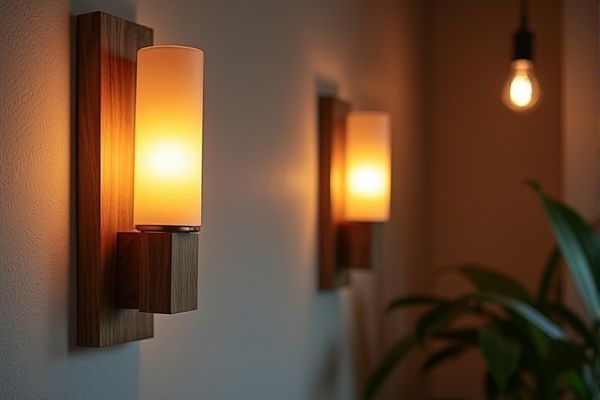
Wall sconces create ambient lighting while saving floor space, ideal for highlighting artwork or narrow hallways, whereas pendant lights serve as focal points that provide direct illumination for tasks and dining areas. Explore the article to discover which lighting option best enhances your room's style and functionality.
Table of Comparison
| Feature | Wall Sconces | Pendant Lights |
|---|---|---|
| Installation Location | Mounted on walls, ideal for hallways, bathrooms, and accent lighting | Hangs from ceiling, suited for kitchens, dining rooms, and task lighting |
| Lighting Coverage | Provides focused or ambient light; good for highlighting artwork or pathways | Offers broad, downward light ideal for workspaces and general illumination |
| Space Saving | Great for small spaces since they don't occupy floor or table space | Requires ceiling height and clearance; adjustable drop for different room sizes |
| Design Styles | Varies from traditional to modern; complements wall decor | Available in diverse styles from minimalist to decorative fixtures |
| Installation Complexity | Relatively easy; attached directly to wall wiring | Moderate; involves ceiling electrical box and height adjustment |
| Typical Use | Accent lighting, mood enhancement, supplementary light | Main lighting source, task lighting, statement pieces |
| Cost Range | Generally affordable; depends on style and finish | Varies widely; can be higher due to size and design complexity |
Introduction to Wall Sconces and Pendant Lights
Wall sconces provide ambient or accent lighting by being mounted directly on walls, ideal for highlighting artwork or creating cozy atmospheres without occupying floor space. Pendant lights hang from the ceiling, offering focused illumination perfect for task lighting over kitchen islands or dining tables. Your choice between these fixtures depends on the room's layout, lighting needs, and design style preferences.
Design Differences: Wall Sconces vs Pendant Lights
Wall sconces are mounted directly on walls, often featuring compact designs that provide localized, ambient, or accent lighting, ideal for hallways or flanking mirrors. Pendant lights hang from the ceiling by a rod or chain, offering a broader illumination area suitable for dining rooms, kitchens, or entryways, with designs ranging from minimalist to elaborate fixtures. The key design difference lies in their placement and light distribution, with sconces enhancing vertical wall space and pendant lights emphasizing overhead lighting.
Space Suitability: Where to Use Each Fixture
Wall sconces are ideal for narrow spaces, hallways, or beside mirrors where they provide focused, ambient lighting without occupying floor or table space. Pendant lights work best in areas with higher ceilings or open layouts, such as kitchens, dining rooms, or entryways, offering direct illumination and serving as statement pieces. Your choice depends on the room's size and ceiling height, ensuring both functionality and aesthetic enhancement.
Lighting Effects and Ambiance
Wall sconces provide soft, ambient lighting by casting light upward or downward, creating a cozy and intimate atmosphere ideal for hallways or accent walls. Pendant lights offer focused illumination, perfect for task lighting over kitchen islands or dining tables, enhancing visual clarity and adding a stylish focal point. Your choice between sconces and pendants will shape the room's mood and functionality by balancing diffused versus direct lighting effects.
Installation Requirements and Considerations
Wall sconces require mounting on existing walls with access to electrical wiring, often necessitating professional installation to ensure secure attachment and proper wiring. Pendant lights need ceiling support capable of bearing their weight, with wiring routed through ceiling fixtures, and may require adjustable ceiling height considerations. Both lighting options must account for electrical codes, space constraints, and the desired ambiance to optimize functionality and aesthetic appeal.
Style Versatility and Aesthetic Appeal
Wall sconces offer sleek, space-saving design options that enhance ambient lighting through subtle, wall-mounted fixtures, ideal for creating cozy atmospheres in hallways and living rooms. Pendant lights provide bold, statement-making features with adjustable heights and diverse shapes, serving as functional focal points in dining areas and kitchens. Both lighting types deliver style versatility and aesthetic appeal by complementing various interior design themes from modern minimalism to classic elegance.
Energy Efficiency and Bulb Options
Wall sconces typically use lower-wattage bulbs and can be fitted with energy-efficient LED or CFL bulbs, making them ideal for subtle, ambient lighting while conserving energy. Pendant lights often accommodate a variety of bulb sizes and styles, offering more flexibility but potentially higher energy consumption depending on the chosen bulb wattage. Your choice between wall sconces and pendant lights should consider the specific energy usage and bulb compatibility to optimize both lighting design and efficiency.
Cost Comparison: Initial and Long-term Investment
Wall sconces typically require a lower initial investment compared to pendant lights due to simpler installation and fewer materials required. Pendant lights often have higher upfront costs driven by design complexity, size, and additional wiring needs. Long-term maintenance expenses for wall sconces tend to be lower, while pendant lights may incur extra costs related to bulb replacements and potential fixture adjustments.
Maintenance and Care Tips
Wall sconces require minimal maintenance, mainly involving dusting and occasional bulb replacement due to their stationary wall placement. Pendant lights may need more frequent cleaning, especially in kitchens or dining areas, as they are exposed to grease and dust from above. To ensure longevity and optimal performance, check wiring connections periodically and use appropriate bulbs for your fixtures.
Choosing the Right Fixture for Your Space
Wall sconces provide focused, ambient lighting ideal for hallways, bathrooms, and accent walls, while pendant lights offer centralized illumination perfect for dining areas and kitchens. Consider ceiling height, room size, and desired light distribution when selecting between them to enhance functionality and style. Prioritizing the fixture's scale and placement ensures optimal lighting balance and aesthetic appeal within your space.
 homyna.com
homyna.com